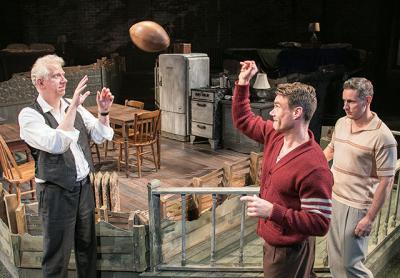Death of the American Dream

Somewhere in the world, an Arthur Miller play is always being performed. Nearby, in Sag Harbor, it happens to be “Death of a Salesman” at Bay Street Theater, running now through Nov. 25.
As “Hamlet” is to Shakespeare, so is “Salesman” to Miller, a Pulitzer Prize-winning masterpiece that became the blueprint for American stage tragedy and the canonical narrative of American capitalism. It has been so endlessly revived and oft-discussed that sometimes it feels as though Willy Loman, its central tragic Everyman character, has rarely stepped offstage since the play opened in 1949.
Under the direction of Joe Minutillo, this drama about a broken salesman, the mirage of the American Dream, conflicted familial love between husband and wife and between father and sons, is part of Bay Street’s Literature Live! series, which aims to bring insight and understanding of curriculum-based literature to students through professionally staged productions. For Mr. Minutillo, a retired educator, this is his fifth Literature Live! directorial credit. Public shows as well as free school-day performances for students and educators are offered.
Willy Loman is first glimpsed as a sagging bulk silhouetted in the doorway of his Brooklyn house, sample suitcases in hand — a salesman who after being on the road for more than 30 years has been garroted by the American Dream. He’s tired and hallucinatory; mysteriously, he keeps getting into minor car crashes. His devoted doormat of a wife, Linda (Carolyn Popp), observes his crumbling and exhorts their adult sons, Biff (a former high school football star who flunked math and never attended college) and Happy (a “philandering bum”), to cheer their ailing father by doing something worthwhile.
There have been five Willys to drag those sample cases across Broadway stages, another earlier this year at the Brooklyn Academy of Music, countless others in regional theaters across the country, and scores more around the world. Dustin Hoffman even played him on the screen. I’ve seen four of them onstage, including Antony Sher’s explosive incarnation in London two years ago. That one and Mr. Hoffman’s film version were the two that instilled genuine sympathy for an otherwise deluded blowhard.
The Bay Street production seems a little awestruck by Miller’s masterpiece, rather than taking it by the scruff of the neck and giving it a good shake. The result is that it’s a really decent staging, but not a distinctive one.
Here, Willy Loman is played by David Manis, who comes with a long list of Broadway credits. He appears ghost-like from the beginning and only occasionally breaks through as a real flesh-and-blood character. The role demands a range of emotions, from spurts of puce-faced, Lear-like rage to sudden surges of childish, incurable optimism to quiet devastation. Mr. Manis delivers a certain sameness in the emotional temperature of far too many scenes, so that instead of starring in one of the greatest tragedies, he often appears to be in an overblown melodrama about a dysfunctional family of losers.
By contrast, Rob DiSario’s Biff, the Lomans’ 34-year-old son, a fallen athletic idol who returns home after a self-im posed exile, is heartbreaking. In his deeply affecting performance, Mr. DiSario is seen grasping for answers, having never overcome a father’s betrayal. And yet Biff continues to search for his father’s approval, which he eventually realizes is only winnable by giving in to the old man’s fantasies. Mr. DiSario’s transition from a rough-hewn jock to a sensitive lost soul is nuanced and gut-wrenching.
Also remarkable is the multilevel, locale-shifting, time-bending set, aided by clever retro projections and sharp sound design. Credit goes to Mike Billings and Dalton Hamilton, as well as Melanie Clifton Harvey for the stellar period wardrobe. Together, their creative engineering presents a stage that often mirrors the nightmarish kaleidoscopic world inside Willy’s head where past and present exist side by side. (Miller’s original title for the play was “Inside His Head.”)
If we are still moved by “Salesman” after all these years, it is for a very basic reason: There’s a bit of Willy Loman in us all. We are all traveling peddlers of sorts, always selling, always looking to pad the commission, fueled by ambitions of prosperity.
Like Willy, what parent does not wish to be a hero in his or her children’s eyes, even if it means constructing an embellished truth for a child to hold on to? And what father or mother has not wobbled in the precarious balance of inspiring children to achieve more than they have without instilling a dread of being a failure?
For school-age audiences, none of that is relevant. Instead, students might grasp Miller’s reminder, which still holds true, that it’s only lucky to live in America so long as you are lucky.
Several characters who surround the Loman family do manage to turn the cutthroat system to their advantage: Charley, the shrewdly benevolent neighbor played here by Neal Mayer, Keith Cornelius as Ben, the entrepreneurial, successful brother, and an especially noteworthy Willy Cappuccio as the industrious Bernard, Charley’s nerdy son who grows up to become a Supreme Court lawyer.
In an era when America appears to have lost touch with its own sense of self-worth, “Death of a Salesman” is a piercing play to revisit. Miller was almost prophetic in his critique of the fraudulence of the American Dream and the harsh realities of every-man-for-himself economics. Sixty-eight years later, we exist inside a consumerist bubble full of false images of beauty and success, where we’ve lost touch with what’s actually important.
And to that, folks, as Linda Loman famously says, “attention must be paid.”
Public performances will continue today through Saturday, and Thanksgiving weekend on Friday, Nov. 24, and Nov. 25, at 7 p.m. Matinees are at 2 p.m. on Sunday and Nov. 26. Tickets range from $20 to $55.
